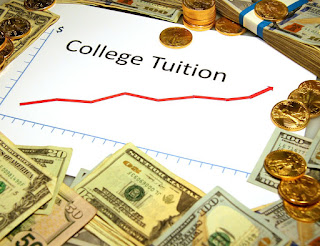Research Blog #4
Topic:
Every year college seems to become more expensive in its year to year cost. With increasing costs, going to college comes with additional stress that is placed on students and parents across the nation. Students will have to decide whether they decide on taking the risk of attending college despite the increasing costs that it presents. With increasing costs of college, students will have to look in other locations to gain financial support for college. For many, this means working part time jobs and taking out thousands of dollars in loans. These loans can affect the future and make it harder for students to progress financially later in life. The financial price of college tends to overshadow the benefits that it may provide for students. With college prices continuing to hike year by year, the value of a college education comes into question. College is not the set all path for every high school graduate and their other endeavors that students can pursue. The student loan debt crisis has increased to tremendous amounts that are inconceivable.. Unless there are remedies to these problems, college enrollment may decrease in the future and may lead many students that were looking forward to pursuing higher education to look elsewhere. The cost of college and repayments of loans brings with it feelings of anxiousness and eeriness that could be avoided if the cost of college was not as high. Evaluating the Return on Investment in Higher Education: An Assessment of Individual- and State-Level Returns discusses how the cost of college can be improved upon with proper decisions from policymakers. Some of these decisions include educating prospective students more effectively about the specific major and programs available at their schools. Additionally, properly educating students about the cost of college and understanding the loan process. A New Approach for Curbing College Tuition Inflation, details that solving this crisis through education of the cost of college is not the appropriate solution. Rather, the solution needs to stem from developing competition between colleges. This in turn will increase the quality of education or make the prices more affordable throughout the nation. Various other sources examine the issue of how the price of college has rose throughout the nation and study the return on investment, value, of obtaining a college education.
Research Question:
As college costs continue to increase throughout the nation, is a college education simply worth what it was decades ago? College tends to leave students in thousands of dollars in debt and can lead to financial stress and pressure; this in turn can take away attention from the academic aspect of college. What solutions can policymakers and colleges implement to ease the effect of the increasing costs of a higher education?
Theoretical Frame
In the article, Is College Worth It? Clearly, New Data Say, David Leonhardt examines how a college education proves to be beneficial throughout one’s lifetime. A college education will extend earnings gain far longer than a typical high school graduate’s earnings. However, he also examines how college education, while certainly useful, can cause increases in the amount of debt that a student feels obligated to take on. However, he highlights the growing cost of college can be explained with the general increasing inflation throughout the nation. Once again, the author shares that more should be done on the government’s end to make the price of college affordable.
The Pew Research document, Is College Worth it?, details the value of college by examining the benefits of each form of degree. As a whole, most of the degrees seem to provide for long-term earnings benefit. College graduates certainly tend to make more than high school graduates. While both of these articles document that, there need to be solutions that make it easier for students to pay for college effectively and more easily.
Other solutions are examined in the articles discussed before; these solutions include the government creating more competition between colleges throughout the nation. Another solution that is important is educating students about examining their options for college and payment.
Case or Example
The New York Times Article discusses how not attending college will set a student back approximately “$500,000”; this means that it is cheaper to attend college than to not attend. This demonstrates the waste benefits of college and the return on investment of college. Knowing this, it is certain that there is a significant value to college. There is a significant long term benefits financially when attending college, but for many this involves paying increasing costs as discussed in the article.

Comments
Post a Comment